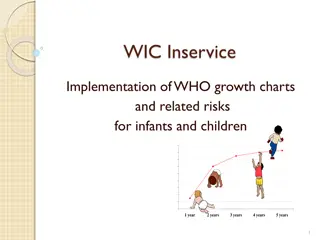Sources of Economic Growth and Outcomes
Factors impacting economic growth include capital and labor inputs contributing to total output, with GDP per capita reflecting the goal of higher output per person. Measuring growth across nations can be challenging due to currency translations and the need to adjust for purchasing power parity. The top ten nations with high GDP per capita consist of mostly small nations with unique economic strengths, while observations highlight various factors influencing economic desirability and standard of living. Even after corrections, questions remain about measurement accuracy.
Download Presentation

Please find below an Image/Link to download the presentation.
The content on the website is provided AS IS for your information and personal use only. It may not be sold, licensed, or shared on other websites without obtaining consent from the author.If you encounter any issues during the download, it is possible that the publisher has removed the file from their server.
You are allowed to download the files provided on this website for personal or commercial use, subject to the condition that they are used lawfully. All files are the property of their respective owners.
The content on the website is provided AS IS for your information and personal use only. It may not be sold, licensed, or shared on other websites without obtaining consent from the author.
E N D
Presentation Transcript
Growth Models Sources of Economic Growth and Outcomes
Factors known to Impact Growth Factors known to Impact Growth Starting point is simple production function Capital and labor as inputs Production as an output Both contribute positively to total output: Output (Y) = F (Capital, Labor) = F (K,L) Economic growth occurs due to rising capital input or rising labor force Ultimately goal is higher output/person (GDP/Capita) Rise in L has dual impact
Measurement Across Nations is Tricky Measurement Across Nations is Tricky Want GDP/Capita But, GDP in Japan is measured in Yen, not dollars First step is to translate foreign GDP into U.S. $s (or vice-versa) to compare Immediate problem: foreign exchange rates are manipulated Will embed errors in the model Also want to correct for the cost of living Much higher in a nation such as Japan, primarily due to space constraints Once done, value is known as GDP at Purchasing Power Parity Now can make some comparisons .still may not be entirely accurate
Top Ten. Top Ten . 1 2 3 4 5 6 7 8 9 Qatar Luxembourg Singapore Brunei Kuwait Norway United Arab Emirates 67,217 Ireland San Marino Switzerland 132,870 99,506 85,382 79,508 70,542 68,591 65,806 62,938 58,647 10
Observations. Observations . Mostly very small nations -> many derive income from oil wealth Ireland became a global financial sector after 2008-09 Has benefited considerably in terms of growth Note that GDP/Capita is only one factor reflecting desirability Singapore is known for draconian political policies -> might not want to live there, even if standard of living high
Also, Even after Corrections, Still some Questions about Measurement https://www.nytimes.com/2005/04/17/weekinreview/were-rich- youre-not-end-of-story.html Large welfare state High income due mostly to North Sea oil Observationally, Norwegians live very simply Prices and taxes are very high-> correction for PPP may not fully account for this VAT taxes, in particular, consume a great deal of spendable income Hence, must use caution when evaluating numbers
Next ten.. Next ten .. 11 12 13 14 15 16 17 18 19 20 United States 56,084 Saudi Arabia 53,802 Netherlands 49,624 Bahrain Sweden Australia Austria Germany Taiwan Denmark Iceland 49,601 48,199 47,644 46,986 46,974 46,833 45,723 45,666
U.S. does Fairly Well in this Ranking U.S. does Fairly Well in this Ranking Top GDP/Capita among large nations Note considerable difference between U.S. and Germany U.S. is very resource rich, and this has produced higher growth Superior farmland, abundant energy Constraints in Africa make GDP/Capita much lower-> arable land is short difficult to attain conditions for take-off to higher growth Also, we tend to work many more hours than the rest of the world About 2 work weeks more on average Work Ethic definitely part of equation China is still ranked around 100 -> very high GDP, very high population
What are we Leaving Out? What are we Leaving Out? Recall discussion at beginning of course GDP reflects output Will be reduced as people take more leisure, yet we LIKE leisure In Japan, death from overwork is an official cause of death If goal is happiness , may not make much sense What about the environment? Defund the EPA and GDP would go up (constraint on GDP) Would we be better off? Most likely not GDP only indirectly reflects aesthetics, art, music, etc. These are thought to reflect on the success of a society
Relationship when Factors other than Capital Relationship when Factors other than Capital and Labor are included and Labor are included In addition to K, L, Land is an input as are raw materials Reformulate as: Y = F(K, L, Land, RM) All have a positive impact on output More difficult to measure Technology One of the primary influences on U.S. economic growth Could also add work ethic as a factor -> proxy labor hours/week Overall equation: Y = F(K, L, Land, RM, technology, Work Ethic) Nation then should seek to maximize output given these inputs
Constraints Constraints Most economic exercises are maximizations subject to a constraint So, we are maximizing Output (Y) using these important inputs, but actual output is lower due to constraints Might be labor laws (minimum wage), environmental laws, etc. Not necessarily a critique -> most of us want drinkable water and breathable air But production is lower as a result A truthful analysis of government policies such consider the costs and benefits Does marginally better water quality justify shutting down industry X? China has, until recently, disregarded environmental impacts, and this has made them a true economic power Costs (very high costs) will come later!
Growth Models Part 2 Simple growth model All models emphasize role of savings as a driver of growth Graphically, S v. I and growth
More Sophisticated Solow Model Starts with I = S equilibrium I = S -> I = sY, where s = mps and Y = GDP Investment accomplishes two things replaces old capital (represented by depreciation) and generates new capital I = dK + K -> where d = rate of depreciation and K = new capital stock multiply top and bottom of second term by K => I = dK + K K/K Pull K out => (d + K/K)K Set equal to S from above: S = (d + K/K)K
At equilibrium, labor force and capital growing at same rate, so that capital intensity remains the same Let n = growth rate of labor = N/N For and equilibrium, growth rate of capital ( K/K) must be the same if k = K/K, then k = n From before: S = (d + K/K)K -> so S = (d + k)K or S = (d + n)K Replacing S with sY => s Y = (d+n)K Finally: divide both sides by N (population) -> s Y /N = (d + n)K/N
This is Final This is Final V Version of Solow ersion of Solow Dividing by N leads to equation that has standard of living on the left (Y/N) version capital stock intensity (K/N) on the right The rest of the variables are fixed Don t change, except in the long run (population growth, depreciation, savings rate) Can now figure out a way to raise the standard of living Is savings rises, the line s (Y/N) rises also Results in a higher level of savings and a higher standard of living since capital intensity is now higher
Graph must Reflect Diminishing Returns to Graph must Reflect Diminishing Returns to Capital Capital Assumed in Model Assumed in Model
Increase in Savings Increase in Savings
If Y/N included.. If Y/N included .. Graph demonstrates standard of living Too hard to draw electronically Shift upwards in s(Y/N) produces higher Y/N Completes Solow s argument regarding savings rates and standards of living
Example.. Example .. Suppose a small economy has a savings rate of 10% (mps = 0.1). The rate of depreciation is 0.08 (8%) and the rate of population growth is 2% (0.02). At present, the GDP of this small nation is $100 million. -What is the total capital stock (capital in place) for this nation? -If the population of this small country is 10,000, what is the GDP per capita? What is capital intensity per person (K/N)? What happens to equilibrium capital intensity if the rate of savings rise to 15% (.15)?
Puzzles Puzzles Savings (and capital accumulation is sole driver of standard of living in model So nations with similar savings rates should have similar outcomes But, as we discussed at the beginning of growth models, Y/N varies a huge amount Attributable mainly to omitted variables -> Two societies with identical rates of savings can have different outcomes due to: Different endowments of resources (e.g. land) Different technologies Differing work ethic
Solow Model was a First Solow Model was a First P Pass ass As with most work in economics, model is proposed and tested Subsequent work introduces variations that are not in original model to see what else is at work Not reasonable to assume that it is only savings rates that determine growth and Y/N Embedding other variables makes the model work better, and has been accepted
Puzzle 2 Puzzle 2 - -> Developing Nations should have a > Developing Nations should have a Higher ROR to Capital Higher ROR to Capital
Developing Nations have less Capital, so Developing Nations have less Capital, so Return to Capital should be Higher Return to Capital should be Higher Developing nations would be found closer to the origin of the graph Additional capital should add more to output than it does when capital accrued in industrialized nations This should pull capital into these countries Not what is observed in the real world Once again, the complexity of factors that determine output is at play As one concrete example, many (most) developing nations have capital controls Regulations prevent capital from freely leaving the country As a result, capital doesn t flow in .
Puzzle #3 -> Non-convergence Model predicts that developing nations should converge with industrialized nations Marginal product of capital higher, so growth should be faster And, over time, developing nations should adopt technological advances common in developed nations This is a maybe , as institutional barriers (e.g. patents) may prevent widespread adoption By the time a lagging nation adopts a computer chip advancement, for instance, the next generation has already been developed Convergence has been very uneven Some nations (Asian Tigers Malaysia, Thailand, Singapore, and Indonesis) have grown rapidly and income/capita approaches that in the industrialized world
Malaysia has a higher GDP per capita (at PPP) than Russia Thailand s GDP at PPP exceeds Brazil s Many smaller developing nations remain quite poor by world standards, so convergence is very uneven























